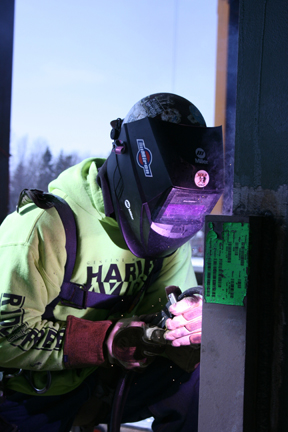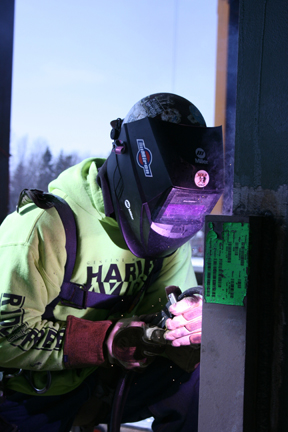Filler Metal Conversion Can Yield Increased Productivity, Efficiency for Contractors

industry look for ways to boost productivity
and efficiency in an increasingly competitive
environment, some are making the switch
from shielded metal arc welding (SMAW) to
self-shielded flux-cored welding (FCAW)
as one way to gain an edge.
As contractors in the structural steel industry look for ways to boost productivity and efficiency in an increasingly competitive environment, some are making the switch in their welding applications from shielded metal arc welding (SMAW) to self-shielded flux-cored welding (FCAW) as one way to gain an edge.
Contractors for many years have relied heavily on the SMAW process to complete most of the on-site fabrication for major infrastructure jobs, namely because it is familiar to many welding operators, it has mobility advantages exceeding other processes and it also is often specified by the welding procedure for many construction applications.
However, in recent years, self-shielded FCAW has helped some contractors improve their businesses. The process is faster, increasing productivity and providing greater cost savings. The productivity advantages and the competitive edge that the self-shielded FCAW process can create for a company should be considered along with the proactive measures that contractors must take in order to transition from SMAW. The conversion may be a trend worth following, but there are things to keep in mind when deciding whether to make the switch.
Requalifying procedures, choosing the filler metal
Whether fabricating components for structural steel erection or constructing portions of a bridge, strict codes regulate the procedure, the materials and the filler metal that can be used during the welding process. For example, American Welding Society (AWS) D1.1 structural welding code and AWS D1.5 bridge welding code dictate the base metal and filler metal combination for these applications, along with the power supplies that can be used.
Under these specifications, a self-shielded flux-cored wire meeting the AWS E71T-8 classification is a common requirement for structural steel applications and one that can be advantageous for contractors to convert to from a SMAW electrode. Also known in various industries as a T-8 wire, this wire, like any filler metal, requires proper technique and training to achieve optimal results.
When the job requires welding to the aforementioned codes and the change is made to a T-8 wire, the contractor will need to requalify welding procedures, as well as the company’s welding operator certifications in order to make the switch in welding processes. These tasks may seem burdensome, but welding operators need to have their certifications requalified periodically anyway. A transition to a self-shielded flux-cored wire can simply facilitate doing it sooner. Ultimately, it’s a change that could result in a faster, easier process for welding operators.
Proper equipment
The second thing to remember when considering a switch to self-shielded FCAW is the need for proper equipment. In the case of using a T-8 wire, contractors will need a constant voltage (CV) power source. Having the proper equipment is absolutely critical for contracting companies that weld to code.
While some contractors may want to save on the cost of the equipment purchase by adding a voltage-sensing feeder to the constant current (CC) power source that is already used for their SMAW process, this system is not acceptable for self-shielded flux-cored welding to AWS code D1.1. That’s because it doesn’t react quickly enough to maintain a steady voltage throughout the welding process. That can lead to weld defects, especially porosity, which can end up costing more money in downtime, rework and possibly contract fees than the up-front cost of new CV power sources.
Choosing the correct wire
The third consideration in making a transition from SMAW to a self-shielded FCAW process is finding the specific type of self-shielded flux-cored wire that is best suited for the application. As mentioned earlier, a T-8 wire is typically the self-shielded flux-cored wire used for structural steel applications. There are a number of options that meet seismic requirements and offer the necessary high impact strengths for critical code work. A filler metal manufacturer or trusted welding distributer can help in making the best selection.
The key to using a T-8 wire, in addition to the necessary training and practice, is a general understanding of its characteristics and operating requirements, and knowledge of how its chemical and mechanical properties are designed to meet the needs of critical structural steel applications.
Classified for premium performance Understanding the various portions of its AWS classification is a good first step in becoming familiar with a T-8 self-shielded flux-cored wire, beginning with its most basic arrangement, E71T-8:
• ‘E’ indicates an electrode.
• ‘7’ refers to the wire’s tensile strength measured in psi (pounds per square inch), or for this classification, 70,000 psi.
• ‘1’ indicates that the wire offers all-position welding capabilities.
• ‘T’ denotes it is a flux-cored wire.
• ‘8’ indicates the usability of the electrode, or in this case, DCEN single- or multi-pass welding.
Due to advances in filler metal manufacturing technology, some T-8 wire also offers added designations for impact strength, seismic requirements and hydrogen content; all are factors that contribute to the suitability and usability of a given manufacturer’s T-8 wire for a specific application.
For example, the addition of the letter ‘J’ to the end of the AWS classification indicates the wire offers high “as welded” impact strength properties at -40 degrees F. A ‘D’ after that indicates the wire can be used for demand-critical welds in special seismic applications. Finally, the presence of ‘H8’ or another similar alphanumeric indicator at the end of the AWS application specifies the amount of diffusible hydrogen in a particular T-8 wire.
Understand the characteristics
If a contractor makes the change to the self-shielded flux-cored process, welding operators should understand the general characteristics and operating requirements of T-8 wire in order to achieve the best weld possible, along with the X-ray quality required for critical applications. Training is important for the conversion to be successful.
Fluctuations in voltage are common on many jobsites and they affect the performance of T-8 wires. The length and condition of welding leads can cause voltage drops between the power source and the workpiece, and that is especially true with long welding leads. Using a multi-meter or a wire feeder with digital voltage meters can help maintain proper voltage range and desirable weld results. Maintaining good weld cable conditions and secure connections between the welding gun and the power source also helps.
The allowable voltage ranges for T-8 wire vary according to a given filler metal manufacturer’s formula, the position in which it is used and, most importantly, the wire feed speed, which directly affects amperage. Generally T-8 wire operates at 200 amps or greater, with a voltage range from 18 to 24 V on an all-position weld regardless of wire diameter. For this reason, it’s always recommended that welding operators weld within those parameters to avoid defects that could lead to time-consuming and costly rework.
Another issue to be aware of is excessive voltage (voltage beyond the highest recommendation for a given T-8 wire), which can cause discontinuities such as porosity or worm-tracking. Conversely, too low of voltage can cause the wire not to wet out properly and lead to cold roll, both problems that can result in weld inspection failure.
Maintaining the welding parameters of a given T-8 wire is additionally dependent on electrode extension, or stickout, and varies according to the filler metal manufacturer. As a rule, most T-8 wire requires a range of 3/4- to 1 1/4-inch, depending on the given diameter used. The general rule is that a smaller-diameter wire will require a shorter stickout than a larger-diameter wire.
Too short of a stickout causes the amperage to increase disproportionately to the voltage setting, which can lead to lack of fusion. Too long of an extension will cause the amperage to be too low for the given voltage setting, leading to incomplete slag coverage and ultimately, any number of weld discontinuities. To help minimize such problems, always check the specific stickout requirements for the T-8 wire being used.
Finally, T-8 wire requires an appropriate gun angle and travel speed in order to prevent slag inclusions. Specific gun angles vary from wire to wire, anywhere from 10 to 45 degrees, and should always be determined according to the recommendations of the given manufacturer. As a rule, the presence of a uniform slag line behind the weld puddle is a good indication that both proper gun angle and travel speed requirements have been achieved.
Final thoughts
Converting from SMAW to the self-shielded FCAW process is an option that can increase productivity and help contractors get the job done faster. However, to get the best results and to meet welding code, welding operator training and proper certification is key. It’s important to have a solid understanding of the characteristics and operating requirements of the new filler metal being used — such as the T-8 wire discussed throughout this article — in order to weld successfully with it.
With the proper training for a chosen manufacturer’s wire, contractors can realize some advantages from T-8 wire and the self-shielded FCAW process, and ensure that quality requirements of critical structural applications continue to be met.



